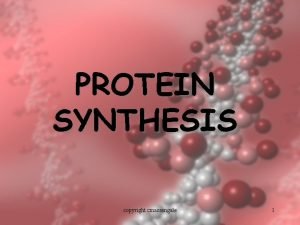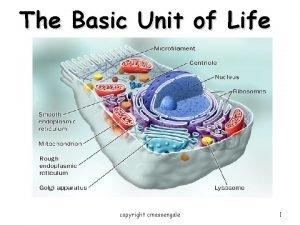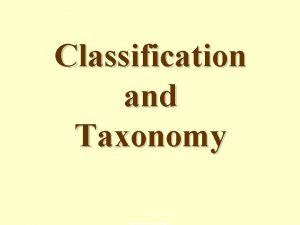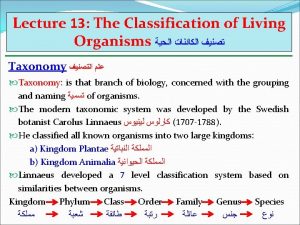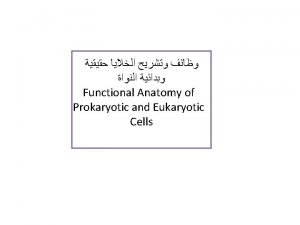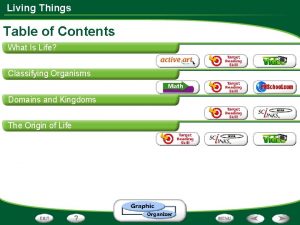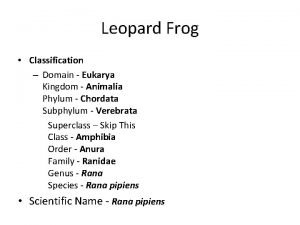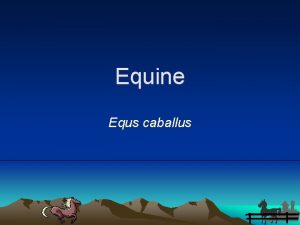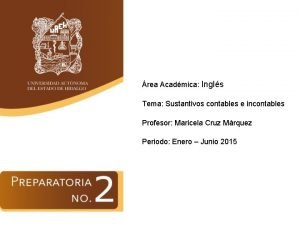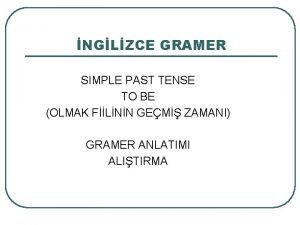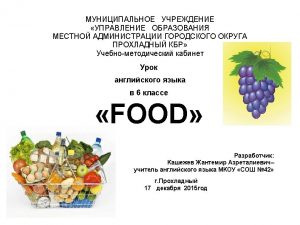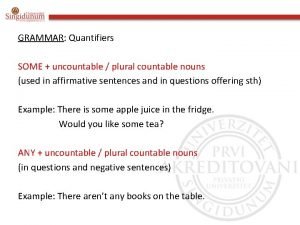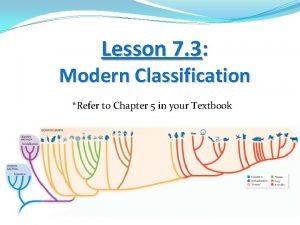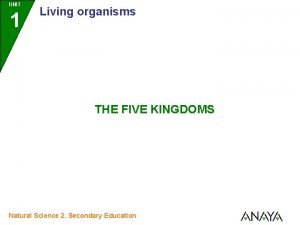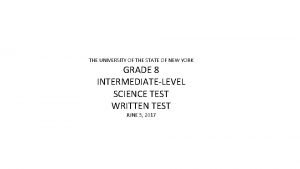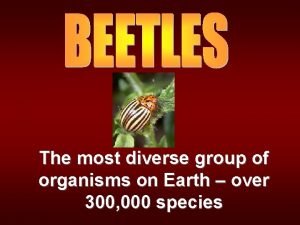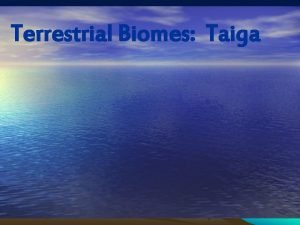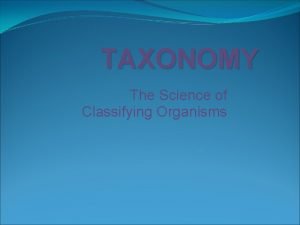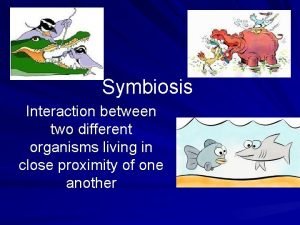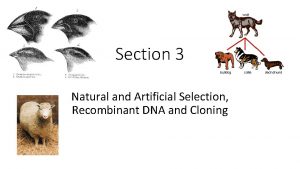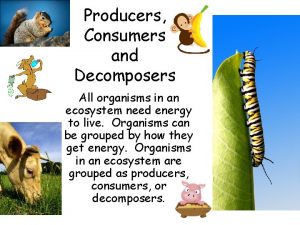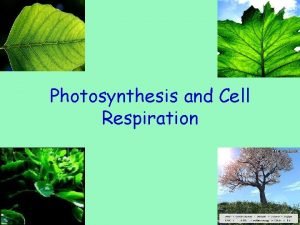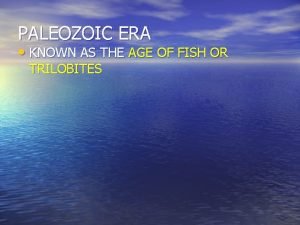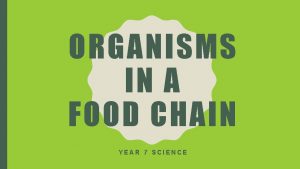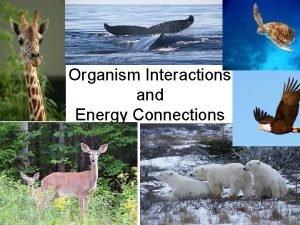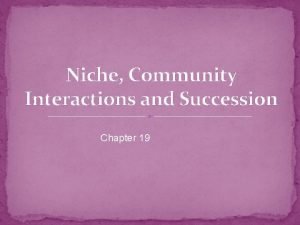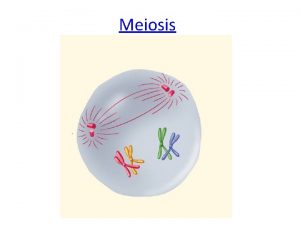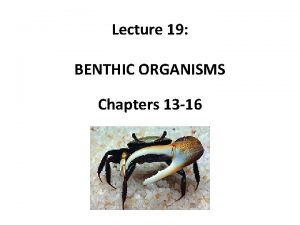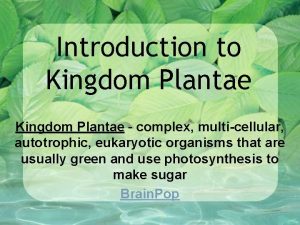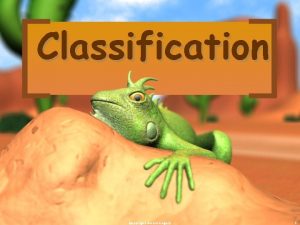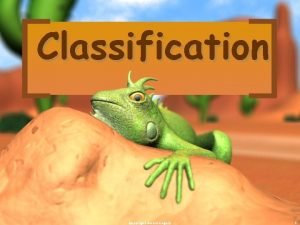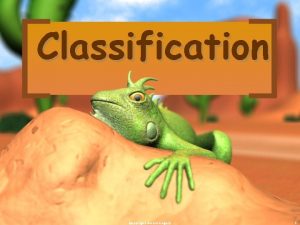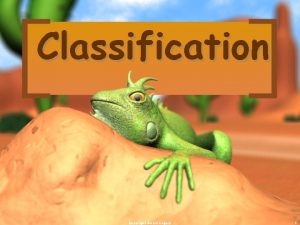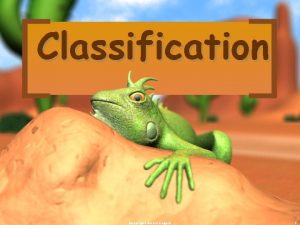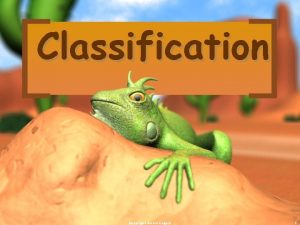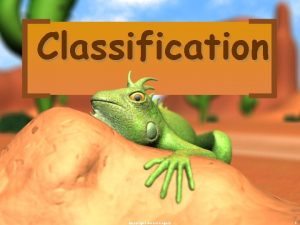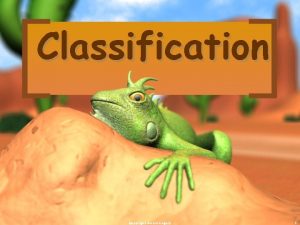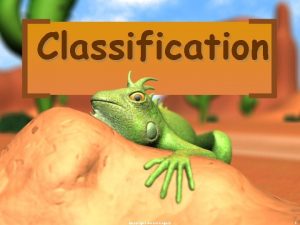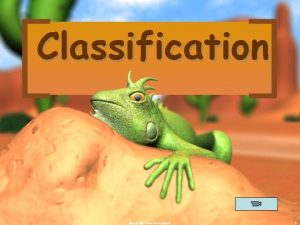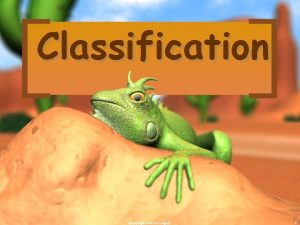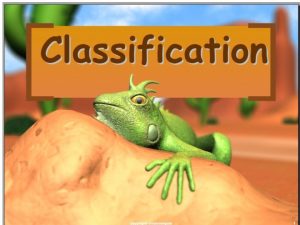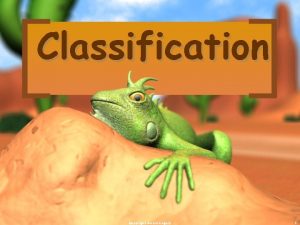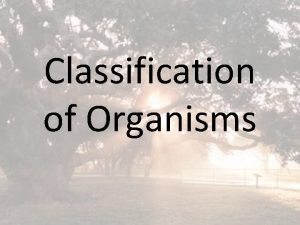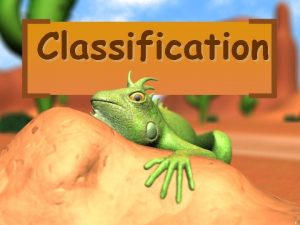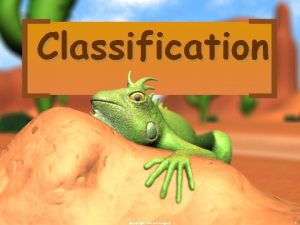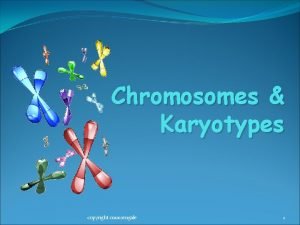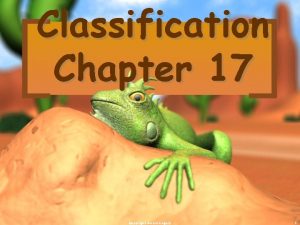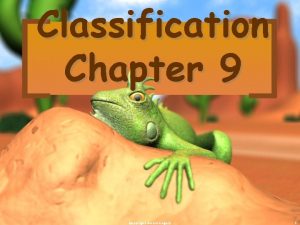Classification copyright cmassengale 1 Species of Organisms There


























































- Slides: 58

Classification copyright cmassengale 1

Species of Organisms • There are 13 billion known species of organisms • This is only 5% of all organisms that ever lived!!!!! • New organisms are still being found and identified copyright cmassengale 2

What is Classification? Classification is the arrangement of organisms into orderly groups based on their similarities Classification is also known as taxonomy Taxonomists are scientists that identify & name organisms copyright cmassengale 3

Benefits of Classifying • organisms Accurately & uniformly names • starfish Prevents misnomers such as & jellyfish that aren't really fish • some Uses same language (Latin or Greek) for all names some Greek) for all names Sea”horse”? ? copyright cmassengale 4

Confusion in Using Different Languages for Names copyright cmassengale 5

Latin Names are Understood by all Taxonomists copyright cmassengale 6

Early Taxonomists • 2000 years ago, Aristotle was the first taxonomist Aristotle divided organisms into plants & animals He subdivided them by their habitat ---land, sea, or air dwellers • • copyright cmassengale 7

Early Taxonomists • John Ray, a botanist, was the first to use Latin for naming His names were very long descriptions telling everything about the plant • copyright cmassengale 8

Carolus Linnaeus • 18 th century taxonomist • Classified 1707 – 1778 • organisms by their structure Developed naming system still used today copyright cmassengale 9

Carolus Linnaeus • Called the “Father of Taxonomy” • Developed the modern system of naming known as binomial nomenclature Two-word name (Genus & species) • copyright cmassengale 10

Standardized Naming • Binomial nomenclature used • Genus species • Latin or Greek • Italicized in print • Capitalize genus, but NOT species • Underline when Turdus migratorius writing American Robin copyright cmassengale 11

Binomial Nomenclature Which TWO are more closely related? copyright cmassengale 12

Rules for Naming Organisms • The International Code for Binomial Nomenclature contains the rules for naming organisms All names must be approved by International Naming Congresses (International Zoological Congress) This prevents duplicated names • • copyright cmassengale 13

Classification Groups • Taxon ( taxa-plural) is a category into which related organisms are placed There is a hierarchy of groups (taxa) from broadest to most specific Domain, Kingdom, Phylum, Class, Order, Family, Genus, species • • copyright cmassengale 14

Hierarchy-Taxonomic Groups BROADEST TAXON Domain Kingdom Phylum (Division – used for plants) Class Order Family Genus Species Most Specific copyright cmassengale 15

Dumb King Phillip Came Over For Gooseberry Soup! copyright cmassengale 16

copyright cmassengale 17

Domains • Broadest, most inclusive taxon • Three domains • Archaea and Bacteria are unicellular prokaryotes (no nucleus or membrane-bound organelles) Eukarya are more complex and have a nucleus and membranebound organelles • copyright cmassengale 18

ARCHAEA • Kingdom - ARCHAEBACTERIA • Probably the 1 cells to evolve • Live in HARSH environments • Found in: –Sewage Treatment Plants (Methanogens) –Thermal or Volcanic Vents (Thermophiles) –Hot Springs or Geysers that are acid –Very salty water (Dead Sea; st Great Salt Lake) - Halophiles copyright cmassengale 19

ARCHAEAN copyright cmassengale 20

BACTERIA • Kingdom - EUBACTERIA • Some may cause DISEASE • Found in ALL HABITATS except harsh ones • Important decomposers for environment • Commercially important in making cottage cheese, yogurt, buttermilk, etc. copyright cmassengale 21

Live in the intestines of animals copyright cmassengale 22

Domain Eukarya is Divided into Kingdoms • Protista (protozoans, algae…) • Fungi (mushrooms, yeasts …) • Plantae (multicellular plants) • Animalia (multicellular animals) copyright cmassengale 23

Protista • Most are unicellular • Some are multicellular • Some are autotrophic, while others are heterotrophic Aquatic • copyright cmassengale 24

Fungi • Multicellular, except yeast • Absorptive heterotrophs (digest food outside their body & then absorb it) Cell walls made of chitin • copyright cmassengale 25

Plantae • Multicellular • Autotrophic • Absorb sunlight to make glucose – Photosynthesis Cell walls made of cellulose • copyright cmassengale 26

• Multicellular • Ingestive heterotrophs Animalia heterotrophs (consume food & digest it inside their bodies) Feed on plants or animals • copyright cmassengale 27

copyright cmassengale 28

Taxons • Most genera contain a number of similar species • The genus Homo is an exception (only contains modern humans) Classification is based on evolutionary relationships • copyright cmassengale 29

copyright cmassengale 30

Basis for Modern Taxonomy • Homologous structures (same structure, different function) Similar embryo development Molecular Similarity in DNA, RNA, or amino acid sequence of Proteins • • copyright cmassengale 31

Homologous Structures (BONES in the FORELIMBS) shows Similarities in mammals. copyright cmassengale 32

Similarities in Vertebrate Embryos copyright cmassengale 33

Cladogram Diagram showing how organisms are related based on shared, derived characteristics such as feathers, hair, or scales copyright cmassengale 34

Primate Cladogram copyright cmassengale 35

Dichotomous Keying • Used to identify organisms • Characteristics given in pairs • Read both characteristics and either go to another set of characteristics OR identify the organism copyright cmassengale 36

Example of Dichotomous Key 1 a 1 b 2 a 2 b 3 a 3 b 4 a 4 b Tentacles present – Go to 2 Tentacles absent – Go to 3 Eight Tentacles – Octopus More than 8 tentacles – 3 Tentacles hang down – go to 4 Tentacles upright–Sea Anemone Balloon-shaped body–Jellyfish Body NOT balloon-shaped - 5 copyright cmassengale 37

Other characteristics to determine classification… copyright cmassengale 38

Body Symmetry: the quality of being made up of exactly similar parts facing each other or around an axis Some animals are asymmetrical, meaning their bodies do not have any certain shape. Some have radial symmetry, meaning their bodies are arranged around a central point. (like spokes on a bicycle wheel). Some animals have bilateral symmetry, meaning the body can be divided lengthwise down the center into two nearly equal halves. • • • copyright cmassengale 39

Symmetrical vs. Asymmetrical copyright cmassengale 40

asymmetry • No particular body shape Ex: sea sponge copyright cmassengale 41

Radial symmetry • Can be divided into similar halves by • passing a plane at any angle along the central axis Ex: sessile bottom-dwelling animals like sea anemone and starfish copyright cmassengale 42

Bilateral symmetry • Line divides body into right and left • halves from head to tail. (mirror symmetry at the sagittal plane) Ex: bees, bats, etc. copyright cmassengale 43

Humans have bilateral symmetry copyright cmassengale 44

Types of Reproduction • Most animals reproduce sexually, • • but some also are able to reproduce asexually. Asexual reproduction requires only one parent. Sexual reproduction usually requires two parents copyright cmassengale 45

Asexual Reproduction • Often uses the process of mitosis • Usually produces offspring that are genetically identical to the parent • Ex: budding, fission, vegetative propagation, spore formation, fragmentation, parthenogenesis copyright cmassengale 46

Euglena binary fission copyright cmassengale 47

Fragmentation- fluke copyright cmassengale 48

Yeast budding copyright cmassengale 49

Vegetative propagation copyright cmassengale 50

Sexual Reproduction • Usually requires a male and a female. • Some animals can produce both male and female gametes • Males and females produce haploid gametes (egg and sperm with half the chromosomes of other cells) • Gametes are produced during meiosis. • Sperm cell fertilizes an egg cell to form a new organism. • Offspring are genetically different from the parents. copyright cmassengale 51

Sexual reproduction • Two types of sexual reproduction • External fertilization- occurs outside the body • Internal fertilization- occurs inside the body copyright cmassengale 52

Sexual reproduction External fertilization Internal fertilization Location of fertilization Female lays eggs in water, male releases sperm into the water. Some of the sperm fertilize some of the eggs outside of the body The male deposits sperm inside the female. The sperm unites with the eggs(s) inside the female. Requirements Always requires water, many animals who live in or near water use this method. (some exceptions) Internal fertilization does not require water Examples Most fish and all amphibians Ex: frogs, toads, salamanders Earthworms, insects, birds, all mammals including aquatic ones (whales and dolphins) Advantages Many offspring= better chance that some will survive Fewer gametes needed. Greater chance of successful fertilization, embryo is protected inside the parent for some animals and has a better chance at survival Disadvantages No protection from predators or the environment, few offspring survive to adulthood copyright cmassengale Elaborate mating rituals are often so that one member of a species doesn’t mistake the other for prey 53

Cellular organization Atom molecule cells tissues organs Organ systems organisms copyright cmassengale 54

Animal vs. Plants copyright cmassengale 55

Types of Animal Tissues • Epithelial tissue: • • • covers body and organ surfaces, lines body cavities, forms glands. Involved with protection, absorption, excretion, secretion, diffusion, and filtration Connective tissue: binds, supports, and protects body parts, stores energy and minerals Muscle tissue: contracts to produce movement Nervous tissue: initiates and transmits nerve impulses that coordinate body activities copyright cmassengale 56

Types of Tissue copyright cmassengale 57

copyright cmassengale 58
 Cmassengale
Cmassengale Cmassengale
Cmassengale Taxons
Taxons Competitive interaction
Competitive interaction Single celled and multi celled organisms
Single celled and multi celled organisms Why is the saguaro cactus a keystone species
Why is the saguaro cactus a keystone species Organisms taxonomy
Organisms taxonomy Fungi cell
Fungi cell Sample classification of organisms
Sample classification of organisms Horse taxonomy
Horse taxonomy Classification of leopard frog from kingdom to species
Classification of leopard frog from kingdom to species Horse classification kingdom
Horse classification kingdom Classification of cow from kingdom to species
Classification of cow from kingdom to species There is there are ejemplos
There is there are ejemplos What part of speech is open
What part of speech is open There is there are negative form
There is there are negative form There is ve there are
There is ve there are Some or any bananas
Some or any bananas There is there are
There is there are All the cds even the scratched one
All the cds even the scratched one Demonstrativos
Demonstrativos правило some any
правило some any El ketchup es contable o incontable
El ketchup es contable o incontable Pep unit
Pep unit There was there were ile ilgili cümleler
There was there were ile ilgili cümleler There is there are exercises
There is there are exercises There is there are
There is there are Hay there is there are
Hay there is there are There's and there are
There's and there are If there is no struggle there is no progress examples
If there is no struggle there is no progress examples Eager learning examples
Eager learning examples Classification and tabulation
Classification and tabulation Traditional classification vs modern classification
Traditional classification vs modern classification Examples of animal organs
Examples of animal organs Multicellular organisms images
Multicellular organisms images Unicellular organisms means
Unicellular organisms means Which principle
Which principle Most diverse group of organisms
Most diverse group of organisms Abyssal zone pictures
Abyssal zone pictures Taiga grassland
Taiga grassland Kingdom phylum class
Kingdom phylum class Dear king phillip came over
Dear king phillip came over Two different organisms living together
Two different organisms living together Artificial selection
Artificial selection Prokaryote vs eukaryote
Prokaryote vs eukaryote What are producers and decomposers
What are producers and decomposers Principles of ecology organisms and their relationships
Principles of ecology organisms and their relationships Parts of photosynthesis
Parts of photosynthesis Pangea paleozoic era
Pangea paleozoic era First order consumer
First order consumer What are the producers in a food web
What are the producers in a food web How do organisms obtain and utilize energy
How do organisms obtain and utilize energy What is an organisms niche
What is an organisms niche Muddy shore biodiversity
Muddy shore biodiversity Growth curve microbiology
Growth curve microbiology Meiosis
Meiosis Living and nonliving things venn diagram
Living and nonliving things venn diagram Suspension and deposit feeding
Suspension and deposit feeding Plant - multicellular eukaryote of the kingdom plantae
Plant - multicellular eukaryote of the kingdom plantae
